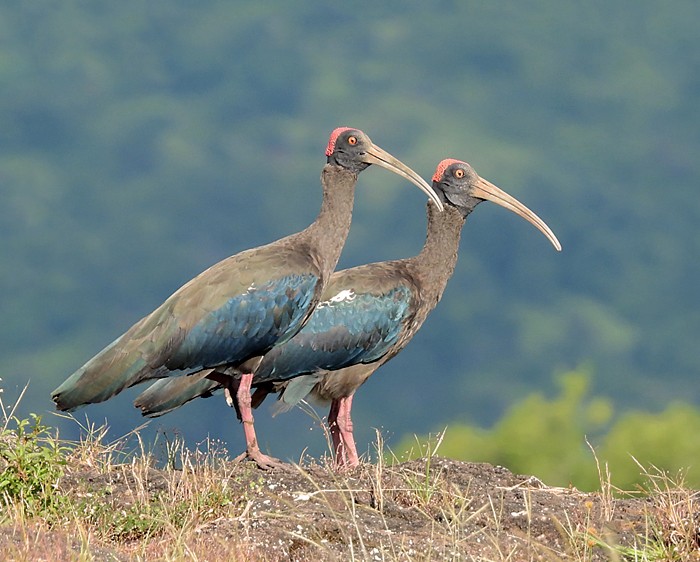Red-naped Ibis
A species of Asian Bare-headed Ibises, Also known as Black Ibis Scientific name : Pseudibis papillosa Genus : Asian Bare-headed Ibises
Red-naped Ibis, A species of Asian Bare-headed Ibises
Also known as:
Black Ibis
Botanical name: Pseudibis papillosa
Genus: Asian Bare-headed Ibises
Content
Description General Info
 Photo By Shantanu Kuveskar , used under CC-BY-SA-4.0 /Cropped and compressed from original
Photo By Shantanu Kuveskar , used under CC-BY-SA-4.0 /Cropped and compressed from original Description
The red-naped ibis is a large black bird with long legs and a long downcurved bill. The wing feathers and tail are black with blue-green gloss while the neck and body are brown and without gloss. A white patch on the shoulders stands out and the top of the featherless head is a patch of bright red warty skin. The warty patch, technically a caruncle, is a triangular patch with the apex at the crown and the base of the triangle behind the nape that develops in adult birds. The iris is orange red. Both sexes are identical and young birds are browner and initially lack the bare head and crown. The bills and legs are grey but turn reddish during the breeding season. The toes have a fringing membrane and are slightly webbed at the base. They are usually silent but call at dawn and dusk and more often when nesting. The calls are a series of loud braying, squealing screams that descend in loudness. This species can be confused with the glossy ibis when seen at a distance but the glossy ibis is smaller, more gregarious, associated with wetlands and lacks the white on the wing and has a fully feathered head. 
Size
68 cm
Colors
Brown
Black
White
Blue
Life Expectancy
20-30 years
Nest Placement
Tree
Feeding Habits
Red-naped Ibis is omnivorous, consuming insects, frogs, carrion, and crops. They forage on dry land, even joining other birds to hunt in freshly tilled soil. Adapted to walk and probe for prey, red-naped Ibis avoids wading but digs for amphibians. They roost communally and may resort to carrion and larvae during droughts.
Habitat
Red-naped Ibis typically inhabit open landscapes including dry grasslands, meadows, and cultivated fields, often at a distance from wetlands. These birds are less reliant on watery environments compared to some related species. Breeding grounds consist of tall trees where they roost and nest, and such trees can be located far from water bodies. Geographically, their range extends across broad plains and they are adapted to thrive in both marshy areas and drier agricultural lands.
Dite type
Scavenger
General Info
Feeding Habits
Bird food type
Distribution Area
The red-naped ibis is widely distributed in the plains of the Indian Subcontinent. The habitats this bird is found at is lakes, marshes, riverbeds and on irrigated farmlands. It is gregarious and generally forages on margins of wetlands in small numbers. It is a common breeding resident in Haryana and Punjab and the Gangetic plain. It extends into southern India but is not found in the forested regions or the arid zone of the extreme southeast of the peninsula or Sri Lanka. The red-naped ibis roosts communally on trees or on islands. 
Species Status
The species has declined greatly in Pakistan due to hunting and habitat loss. The species has been largely unaffected in India and they are traditionally tolerated by farmers. The species is considered to be secure in the wild but a few zoos including the ones at Frankfurt, Singapore (Jurong park) have successfully bred the species in captivity. An individual lived in captivity at Berlin zoo for 30 years. 
Scientific Classification
Phylum
Chordates Class
Birds Order
Pelicans and Relatives Family
Ibises and spoonbills Genus
Asian Bare-headed Ibises Species
Red-naped Ibis